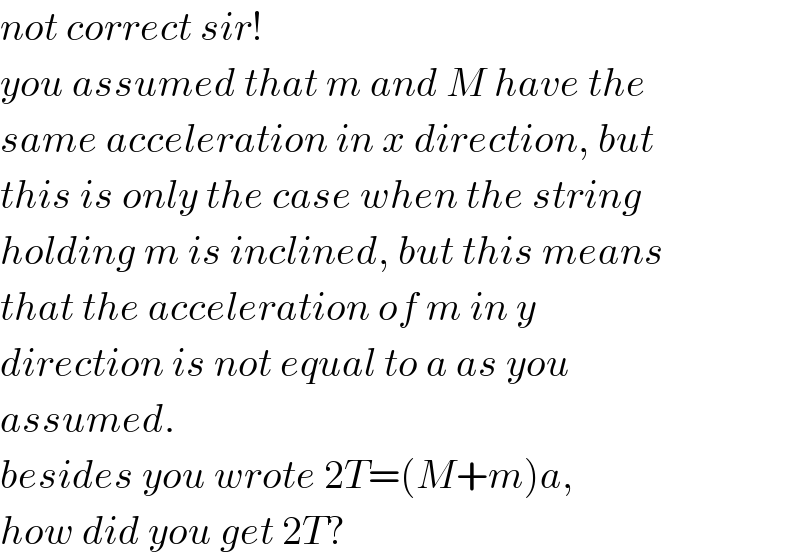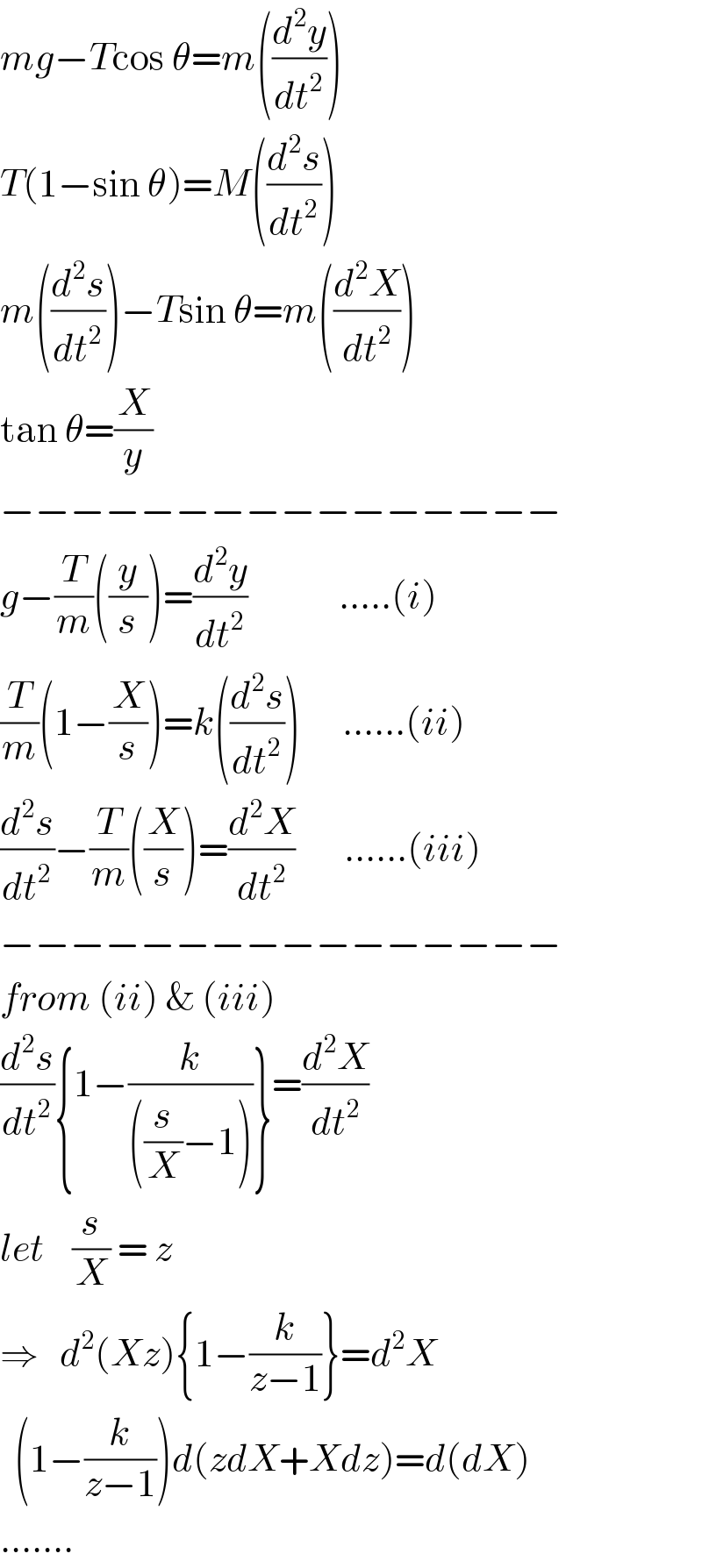
Question Number 109268 by mr W last updated on 22/Aug/20

Commented by mr W last updated on 22/Aug/20

$${block}\:{m}\:{is}\:{released}\:{at}\:{height}\:{h}. \\ $$$${find}\:{the}\:{time}\:{it}\:{needs}\:{to}\:{reach}\:{the} \\ $$$${ground}. \\ $$$${all}\:{motion}\:{is}\:{frictionless}. \\ $$
Commented by Dwaipayan Shikari last updated on 22/Aug/20

$${mg}−{T}={ma}\:\:\: \\ $$$$\mathrm{2}{T}=\left({M}+{m}\right){A}\:\left(\mathrm{2}{T}={total}\:{tension}\:{in}\:{x}\:{direction}\:{for}\:{block}\:\left({M}+{m}\right)\right. \\ $$$$ \\ $$
Commented by mr W last updated on 22/Aug/20

$${not}\:{correct}\:{sir}! \\ $$$${you}\:{assumed}\:{that}\:{m}\:{and}\:{M}\:{have}\:{the} \\ $$$${same}\:{acceleration}\:{in}\:{x}\:{direction},\:{but} \\ $$$${this}\:{is}\:{only}\:{the}\:{case}\:{when}\:{the}\:{string} \\ $$$${holding}\:{m}\:{is}\:{inclined},\:{but}\:{this}\:{means} \\ $$$${that}\:{the}\:{acceleration}\:{of}\:{m}\:{in}\:{y}\: \\ $$$${direction}\:{is}\:{not}\:{equal}\:{to}\:{a}\:{as}\:{you} \\ $$$${assumed}. \\ $$$${besides}\:{you}\:{wrote}\:\mathrm{2}{T}=\left({M}+{m}\right){a}, \\ $$$${how}\:{did}\:{you}\:{get}\:\mathrm{2}{T}? \\ $$
Commented by mr W last updated on 22/Aug/20

$${for}\:{block}\:{m}\:{there}\:{is}\:{not}\:{tension}\:{force} \\ $$$${in}\:{x}\:{direction}. \\ $$
Commented by Dwaipayan Shikari last updated on 22/Aug/20

$${I}\:{have}\:{assumed}\left(\:{M}+{m}\right)\:{as}\:{system}.\:{if}\:{M}\:{goes}\:{inx}\:{direction}\:{then} \\ $$$${mass}\:{will}\:{also}\:{move}\:{in}\:{x}\:{direction} \\ $$
Answered by mr W last updated on 22/Aug/20

Commented by ajfour last updated on 22/Aug/20
![T(1−sin θ)=M((d^2 s/dt^2 )) mgcos θ+m((d^2 s/dt^2 ))sin θ−T=m[(d^2 s/dt^2 )−R((dθ/dt))^2 ] m((d^2 s/dt^2 ))cos θ−mgsin θ = ms((d^2 θ/dt^2 )) −−−−−−−−−−−−−−−−−− let (M/m)=k ⇒ gcos θ+((d^2 s/dt^2 ))sin θ−(k/((1−sin θ)))((d^2 s/dt^2 )) = (d^2 s/dt^2 )−R((dθ/dt))^2 & (d^2 s/dt^2 )cos θ−gsin θ=s((d^2 θ/dt^2 )) .....................................................](Q109314.png)
$${T}\left(\mathrm{1}−\mathrm{sin}\:\theta\right)={M}\left(\frac{{d}^{\mathrm{2}} {s}}{{dt}^{\mathrm{2}} }\right) \\ $$$${mg}\mathrm{cos}\:\theta+{m}\left(\frac{{d}^{\mathrm{2}} {s}}{{dt}^{\mathrm{2}} }\right)\mathrm{sin}\:\theta−{T}={m}\left[\frac{{d}^{\mathrm{2}} {s}}{{dt}^{\mathrm{2}} }−{R}\left(\frac{{d}\theta}{{dt}}\right)^{\mathrm{2}} \right] \\ $$$${m}\left(\frac{{d}^{\mathrm{2}} {s}}{{dt}^{\mathrm{2}} }\right)\mathrm{cos}\:\theta−{mg}\mathrm{sin}\:\theta\:=\:{ms}\left(\frac{{d}^{\mathrm{2}} \theta}{{dt}^{\mathrm{2}} }\right) \\ $$$$−−−−−−−−−−−−−−−−−− \\ $$$${let}\:\:\:\:\frac{{M}}{{m}}={k}\:\:\:\:\:\:\Rightarrow \\ $$$${g}\mathrm{cos}\:\theta+\left(\frac{{d}^{\mathrm{2}} {s}}{{dt}^{\mathrm{2}} }\right)\mathrm{sin}\:\theta−\frac{{k}}{\left(\mathrm{1}−\mathrm{sin}\:\theta\right)}\left(\frac{{d}^{\mathrm{2}} {s}}{{dt}^{\mathrm{2}} }\right) \\ $$$$\:\:\:=\:\frac{{d}^{\mathrm{2}} {s}}{{dt}^{\mathrm{2}} }−{R}\left(\frac{{d}\theta}{{dt}}\right)^{\mathrm{2}} \:\:\:\:\:\& \\ $$$$\frac{{d}^{\mathrm{2}} {s}}{{dt}^{\mathrm{2}} }\mathrm{cos}\:\theta−{g}\mathrm{sin}\:\theta={s}\left(\frac{{d}^{\mathrm{2}} \theta}{{dt}^{\mathrm{2}} }\right) \\ $$$$..................................................... \\ $$
Commented by mr W last updated on 22/Aug/20

$${thanks}\:{sir}! \\ $$$${a}\:{solution}\:{even}\:{for}\:{this}\:{simple}\:{case} \\ $$$${seems}\:{not}\:{to}\:{be}\:{easy}. \\ $$
Commented by ajfour last updated on 22/Aug/20

$${mg}−{T}\mathrm{cos}\:\theta={m}\left(\frac{{d}^{\mathrm{2}} {y}}{{dt}^{\mathrm{2}} }\right) \\ $$$${T}\left(\mathrm{1}−\mathrm{sin}\:\theta\right)={M}\left(\frac{{d}^{\mathrm{2}} {s}}{{dt}^{\mathrm{2}} }\right) \\ $$$${m}\left(\frac{{d}^{\mathrm{2}} {s}}{{dt}^{\mathrm{2}} }\right)−{T}\mathrm{sin}\:\theta={m}\left(\frac{{d}^{\mathrm{2}} {X}}{{dt}^{\mathrm{2}} }\right) \\ $$$$\mathrm{tan}\:\theta=\frac{{X}}{{y}} \\ $$$$−−−−−−−−−−−−−−−− \\ $$$${g}−\frac{{T}}{{m}}\left(\frac{{y}}{{s}}\right)=\frac{{d}^{\mathrm{2}} {y}}{{dt}^{\mathrm{2}} }\:\:\:\:\:\:\:\:\:\:\:\:\:.....\left({i}\right) \\ $$$$\frac{{T}}{{m}}\left(\mathrm{1}−\frac{{X}}{{s}}\right)={k}\left(\frac{{d}^{\mathrm{2}} {s}}{{dt}^{\mathrm{2}} }\right)\:\:\:\:\:\:......\left({ii}\right) \\ $$$$\frac{{d}^{\mathrm{2}} {s}}{{dt}^{\mathrm{2}} }−\frac{{T}}{{m}}\left(\frac{{X}}{{s}}\right)=\frac{{d}^{\mathrm{2}} {X}}{{dt}^{\mathrm{2}} }\:\:\:\:\:\:\:......\left({iii}\right) \\ $$$$−−−−−−−−−−−−−−−− \\ $$$${from}\:\left({ii}\right)\:\&\:\left({iii}\right) \\ $$$$\frac{{d}^{\mathrm{2}} {s}}{{dt}^{\mathrm{2}} }\left\{\mathrm{1}−\frac{{k}}{\left(\frac{{s}}{{X}}−\mathrm{1}\right)}\right\}=\frac{{d}^{\mathrm{2}} {X}}{{dt}^{\mathrm{2}} } \\ $$$${let}\:\:\:\:\frac{{s}}{{X}}\:=\:{z} \\ $$$$\Rightarrow\:\:\:{d}^{\mathrm{2}} \left({Xz}\right)\left\{\mathrm{1}−\frac{{k}}{{z}−\mathrm{1}}\right\}={d}^{\mathrm{2}} {X} \\ $$$$\:\:\left(\mathrm{1}−\frac{{k}}{{z}−\mathrm{1}}\right){d}\left({zdX}+{Xdz}\right)={d}\left({dX}\right) \\ $$$$....... \\ $$
